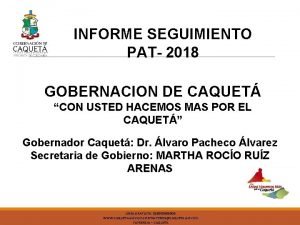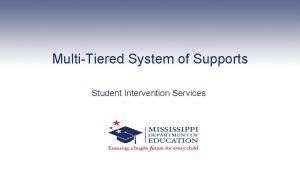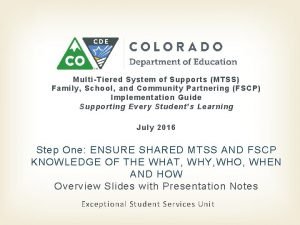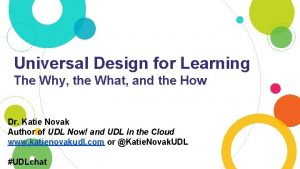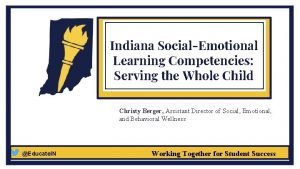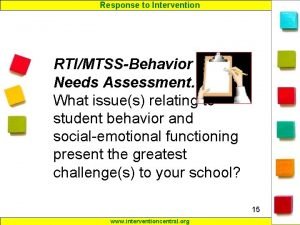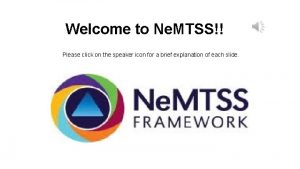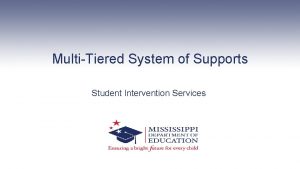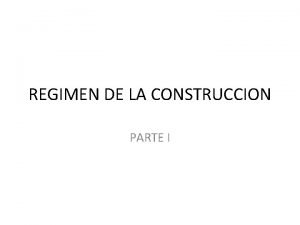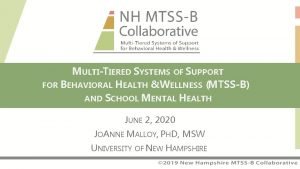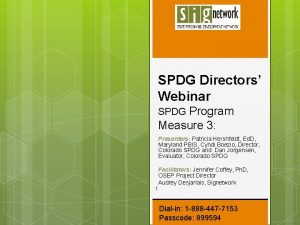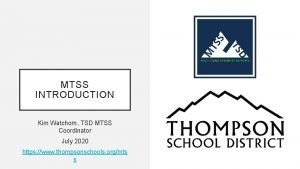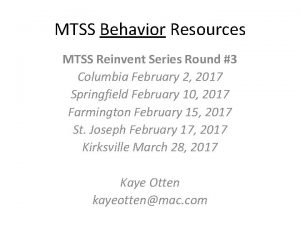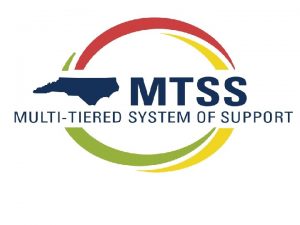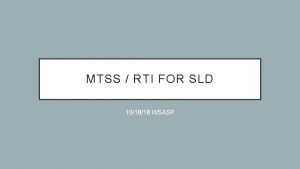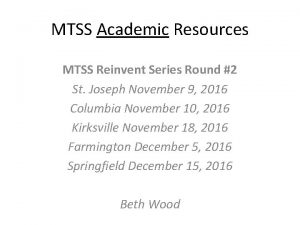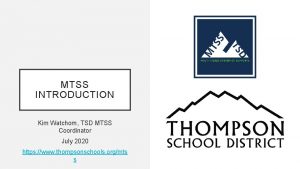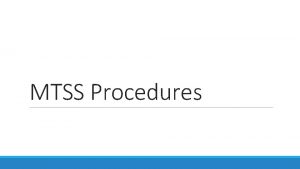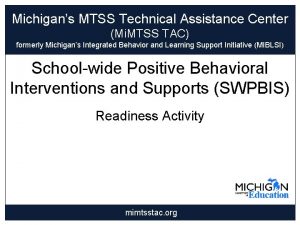Vermont Early Childhood MTSS Pat Mueller VT SPDG
















- Slides: 16

Vermont Early Childhood MTSS Pat Mueller, VT SPDG

School Districts /LEA School Based and School Operated Public Pre. K Partnerships Licensed Childcare Private and Non-profit Head Start Private Preschool and Childcare Non-regulated/informal Childcare Family Childcare Home

Early Mul. Ti-Tiered System of Supports (MTSS) Inclusion Goals • • • To provide High Quality Inclusion for young Children with Disabilities To enhance practitioner knowledge and use of EBPs & DEC Recommended Practices to support inclusion To provide systems design to ensure program wide implementation and sustainability of EBPs To increase LEAs capacity to offer a full continuum of educational placement options To build a sustainable statewide system of high quality inclusive learning environments for each and every child

5 Key Components of Early MTSS Systems Building 1. 2. 3. Strong System Support Functioning Leadership Team Staff Commitment Supportive Systems 4. Partnership & Collaboration Family Partnership Early Childhood Community Based Partners Transition (including K-3 transition) Well-Designed Professional Development Identification of Staff need Provision of Professional Development Supports Assessment of Learning and Implementation 5. Provision of High Quality & Responsive Learning Environments Social and Emotional Confidence and Competence Early Learning (Literacy) Confidence and Competence Early Learning (Numeracy) Confidence and Competence Comprehensive & Functional Assessment system Effective Problem Solving Process Data-Based Decision Making Promotes Ongoing Improvement

Systems Inventory Used by programs to assess progress so that Early MTSS initiatives are implemented with fidelity, sustainable and benefit children and families Grounded in the science of implementation Bridges gap between evidence based practices (EBP) and high fidelity implementation of practice Goal Setting Tool for Professional Development

Early MTSS Systems Inventory Critical Element: Well Designed Professional Development

Program Inventory Summary Data 2. 50 2. 00 1. 50 1. 00 0. 50 0. 00 Systemic Support Partnerships Professional Development Jan. 2014 Jan. 2015 Learning Environment Assessment

Goal Setting 1. Identifying Areas for Improvement 2. Considering Evidence 3. Developing an Answerable Question 4. Making a Decision 5. Monitoring and Evaluating Progress

9 Early MTSS Goal Setting Tool includes 5 Step Learning Cycle http: //community. fpg. unc. edu/connect-modules/instructor-community/module-1/Training. Module-on-Early-Childhood-Inclusion

Vermont Multi-Tiered System of Supports Early MTSS and K-12 MTSS Comparison

n tio s a t p en STATE Team AOE/ RTT-ELC o plem o L n im o k ta a c and d a db back e g feed e F idin ov Pr REGIONAL Early Childhood Council SU and /or Local Early Childhood Program Leadership Team Early Childhood Classroom, Teachers, Home- Visitors, Children and Families y. t it ec fidel f f e or with f s ort nted p up eme s ng impl i d i ov ices r P ct pra t r o p p u S Lo s p o ive

se p o lem Loa on imp k dat c a ck and b d ba ov Pr Program Classroom • • • All staff receive training on EBPs Coach supports practice Coach conducts pre and post via TPOT & ICP • • Early MTSS Cocoordinators • Cadre of Trainers, Coaches • Contract with nat’l experts • Data Analysis and Continuous Improvement Regional e g feed e F idin • • State n tio a t n Leadership Team Designates Internal coach Receive Training Receives external coach Early MTSS Systems Inventory BBF Council • Designates member as internal systems coach • Develops Regional Systems Inventory s ve y. p oo ffecti fidelit L r e ith o f t s w r port nted o p sup me p iding imple u S ov es Pr ctic pra

Leadership Team External Systems Coach Practice-based Coach Cohort Site Evaluation Fidelity Measures • Administrator, teaching staff, parent, special educator • Early MTSS Agreement * • Ensures sustainability of practice • State Cadre of Systems Coaches receive intensive and ongoing training • Supports completion of systems inventory • Supports development and follow through of systems implementation plan • Collects, analyzes and reports pre/post data • State Cadre of Practice Coaches receive intensive and ongoing training in Practice Based Coaching training and community of practice support • Supports teaching staff EBPs • Completes TPOT and Inclusive Classroom Profile as pre and post data • Dialogue with admin and staff to develop action plan • Supports implementation of Pyramid Model EBP and ICP action plan • All staff and admin (ownership) • Receive train-coach-train PD • Internal coaches • Materials and resources to share with families • Strategies to include families • Program wide Systems Inventory • TPOT • ICP • SSIS • Building family partnerships


All children have access to high quality 15 early learning environments and all providers support all children. Service Providers, classroom teachers and support staff plan intentional interventions. Instruction is embedded in daily routines and the curriculum. IEP services are provided In classrooms. Service providers are itinerant. Children receive IEP services outside of their Preschool classroom. (hallway, therapy room, etc. )

Pat Mueller pat@eecvt. com 802 -434 -5607
 Pat mueller
Pat mueller Early childhood adolescence
Early childhood adolescence Pat pat seguimiento
Pat pat seguimiento Benefits of mtss
Benefits of mtss Mtss infographic
Mtss infographic Mtss documentation packet
Mtss documentation packet Mtss
Mtss Mtss and udl
Mtss and udl Indiana sel competencies
Indiana sel competencies Mtss needs assessment
Mtss needs assessment Mtss nebraska
Mtss nebraska Mtss meme
Mtss meme Mtss documentation packet
Mtss documentation packet Decreto 283/996
Decreto 283/996 Mtss-b
Mtss-b Early childhood is ____ for language learning
Early childhood is ____ for language learning Facts about amelia earhart's childhood
Facts about amelia earhart's childhood


